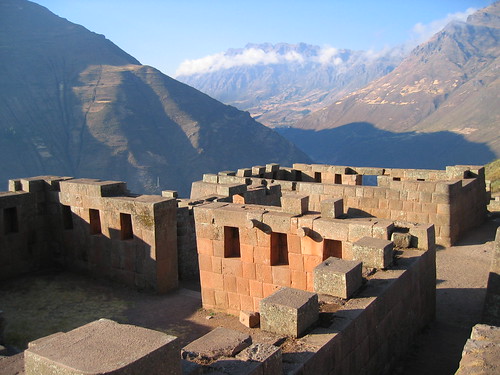
The pre-Columbian cultures continue to fascinate, and about 80 km from Cuzco, the capital of the Inca Empire, is another monumental archaeological settlement: Ollantaytambo, the only city in the Inca empire in Peru still inhabited, built on 2 mountains in a very strategic which dominates the entire valley.
Ollantaytambo was a military, religious, administrative and agriculture, today live in their palaces the descendants of the noble houses of Cusco. His name is a compound Quechua word that derives from «Ollantay, personal name, and» Tambo «, is Spanish for» Tanpu city that offers accommodation and meals for travelers. «Ollantay was an Inca captain whose story was saved as an oral and written tradition, and as a drama by Antonio Valdez, a priest of Urubamba, in the middle of the eighteenth century, was adapted for a play and opened in 1780. According to legend, the fortress belonged to Ollantay, who fell in love with Princess Cusi Coyllor, daughter of the Inca Pachacutec, who did not agree with that relationship because the suitor was not Inca descent and therefore decided to send the princess the house of virgins chosen. Ollantay insisted and went looking for her beloved to the convent where she was surprised, but managed to flee back to their strength and prove to the Inca. After tough resistance strength Ollantay fell and was taken prisoner. Inca Pachacutec finally showed their generosity in pardoning Ollantay life.
The entrance to Ollantaytambo is at the door call-Punku Punku, and any «tambo», endowed with huge deposits of food, good roads and places of astronomical observation. It is characterized by the proper distance to Cuzco ie to be at a trunk road or Main Incanato, which facilitated the rest of the travelers to places of great importance, as in this case, the Citadel of Machu Picchu.
According to some scholars and historians, the architectural ensemble of the stage belongs to Ollantaytambo Inca Imperial conquerors who preceded by only 150 to 200 years. The apparent that there was little time between design and construction of the granite citadel or fortress, to many researchers to doubt regarding their true origin. The defenses that are geared towards Cuzco, as if they wanted to defend the city of the Incas themselves, are another of the riddles presented Ollantaytambo. The strength shown in the proactive spirit of the Incas that the supply of water through underground aqueducts, whose catchment areas were state secrets in his time and even now are not discovered. At the top are discovered gigantic blocks that apparently belonged to the Temple of the Sun, which was destroyed and its pieces scattered on the floor. For these reasons Ollantaytambo is the clearest proof of the procedure that the Incas had to make their buildings, because here is the source, extraction, cutting, transportation and assembly of the perfect stone for the subsequent construccion of the impressive sets archaeological until today we can admire.
It is highly recommended to visit the Museum of Traditional Andean Center for Technology and Culture of the Communities of Ollantaytambo (CATCCO) because it is so educational and modern history of the region. It contains five rooms on the second floor of a mansion on an ancient Inca stadium, allowing visitors to learn more about the history, archeology, architecture, crafts and beliefs of the people of Ollantaytambo. Moreover, this association organizes walks through seven ancestral routes: Yanacocha Pincuylluna, Pumamesarca, Puno, Huílloc, Pacha, Cachicata and Ollantaytambo. The walks take from three to seven hours and have tour guides.
How to get there?
At an average altitude of 2.792 meters above sea level, Ollantaytambo is located 80 km northeast of the city and 40 km from Cuzco to Machu Picchu by train, in the district of Ollantaytambo, province of Urubamba, department of Cuzco in Peru.
By Road: Buses depart every day from Grau Avenue (Cuzco) every 15 minutes. If you come to Urubamba first, take the combis in the terminal of Urubamba. To return to Cuzco or go to Chinchero, take the bus terminal in Urubamba.
Taxis: The taxi service performed daily from Av Pavit (Cuzco) with a cost of 6 soles (SS pull). The rental of the taxi for a day, costs an average of $ 50.
Tours: A tour organized by one agency costs about $ 35 per person including the guide. You need to have the tour ticket, otherwise, pay a visit every archaeological site on this route.
One Response to “Ollantaytambo Inca city”
Leave a Reply
You must be logged in to post a comment.
marzo 18th, 2012 at 12:59 pm
[…] has argued that the fortress was built in the time of the Incas, about 1.400 during the reign of the Inca Tupac Yupanqui, but may have had an earlier […]